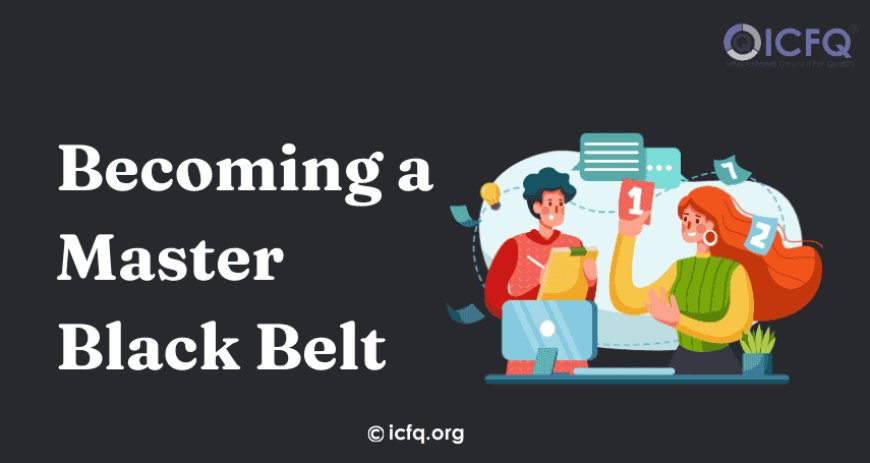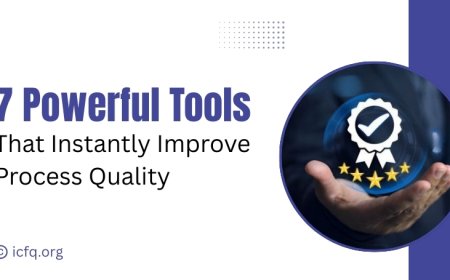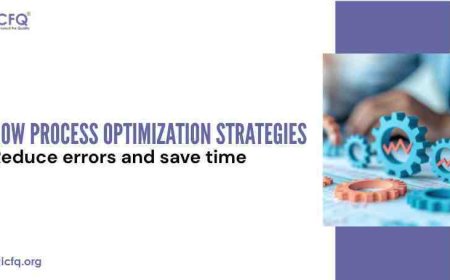Becoming a Master Black Belt: Six Sigma Leadership Tips
Master Black Belt in Six Sigma requires technical expertise and leadership. Learn key tips for guiding teams, driving change, and achieving organizational success.

Six Sigma is a data-driven methodology used by organizations worldwide to eliminate defects, improve processes, and deliver consistent results. One of the highest achievements within this methodology is becoming a Master Black Belt (MBB). The path to Master Black Belt status is not only about mastering technical skills and statistical tools but also about developing leadership abilities that can drive change, inspire teams, and influence strategic decisions at an organizational level.
Whether you’re aspiring to be a Master Black Belt or are in the early stages of your Six Sigma journey, I will provide valuable insights into key leadership tips and strategies that will help you reach the prestigious level of Master Black Belt.
Develop Deep Expertise in Six Sigma Tools and Methodologies
A Master Black Belt needs to be an expert in Six Sigma principles, tools, and techniques. As a leader in this space, you are expected to guide others through complex projects and troubleshooting. You must understand the intricacies of various methodologies, including DMAIC (Define, Measure, Analyze, Improve, Control), DFSS (Design for Six Sigma), and Lean Six Sigma. Having a deep understanding of how these tools can be applied across different industries will help you in guiding teams to achieve optimal results.
Key actions:
-
Learn advanced data analysis techniques, such as identifying patterns, testing assumptions, comparing group differences, and designing experiments to gather reliable insights.
-
Practice applying Six Sigma tools in real-world scenarios to ensure that you can provide practical advice to your team.
-
Attend workshops, read books, and pursue certifications that can deepen your technical expertise.
Cultivate Effective Communication Skills
As a Master Black Belt, you will work with different teams, stakeholders, and departments, including senior management. It’s essential to communicate your ideas, data-driven insights, and recommendations effectively. Strong communication can bridge the gap between technical and non-technical stakeholders, ensuring that everyone is aligned with the goals of the project.
Key actions:
-
Practice presenting complex data in a simple and compelling way, focusing on outcomes rather than the technical details.
-
Develop listening skills to understand the needs and concerns of team members and stakeholders.
-
Hone your ability to tell a story with data, making the results relatable and actionable.
Adopt a Coaching and Mentoring Mindset
Master Black Belts are often tasked with coaching and mentoring Green Belts, Black Belts, and other professionals involved in Six Sigma projects. It’s important to adopt a servant leadership approach—helping others grow while simultaneously driving results. Being a mentor is not just about imparting knowledge; it’s about guiding others through challenges, offering support, and fostering a culture of continuous improvement.
Key actions:
-
Take time to understand the strengths and weaknesses of your team members, offering individualized guidance and feedback.
-
Encourage a collaborative environment where team members feel comfortable asking questions and offering suggestions.
-
Lead by example, demonstrating the behaviors and attitudes you expect from others.
Focus on Change Management
Six Sigma initiatives often require significant changes in organizational processes, which can meet resistance. A Master Black Belt must be adept at managing change. This involves not only convincing stakeholders of the benefits but also ensuring that the changes are implemented smoothly and sustained over time. Effective change management will ensure that Six Sigma projects have a lasting impact on the organization.
Key actions:
-
Develop a clear change management plan for each project, outlining the key stakeholders, necessary resources, and expected outcomes.
-
Use data and storytelling to build a compelling case for change.
-
Address any resistance early in the process and ensure that all stakeholders are on board with the transformation.
Master Project Management Skills
A Master Black Belt needs to be an excellent project manager in addition to having technical expertise. As a leader, you’ll often be responsible for overseeing multiple projects at once. You need to ensure that all projects are on schedule, within budget, and delivering the expected results. This requires careful planning, time management, and risk mitigation strategies.
Key actions:
-
Use project management tools such as Gantt charts, Kanban boards, or project management software to keep projects organized.
-
Set clear milestones and KPIs to monitor progress and make adjustments as needed.
-
Balance competing priorities and resources, ensuring that each project receives the necessary attention.
Build Strong Relationships with Senior Leadership
Master Black Belts are expected to influence decision-making at the highest levels of an organization. Building relationships with senior leadership is key to gaining their trust and securing the resources needed to execute Six Sigma initiatives. A strong rapport with executives will ensure that your Six Sigma projects align with organizational strategy and are supported across departments.
Key actions:
-
Regularly communicate progress, outcomes, and insights from Six Sigma projects to senior leadership.
-
Understand the strategic goals of the organization and align Six Sigma initiatives with those objectives.
-
Position yourself as a trusted advisor who can provide data-backed recommendations for organizational improvement.
Be a Change Agent for Organizational Culture
As a Master Black Belt, you are not only a project leader but also a cultural leader. You will be instrumental in shaping and promoting an organizational culture that values data-driven decision-making, continuous improvement, and operational excellence. Encouraging a culture of collaboration, transparency, and learning will be essential for sustaining the success of Six Sigma.
Key actions:
-
Lead initiatives that promote cross-departmental collaboration and knowledge sharing.
-
Encourage continuous learning by facilitating training sessions, workshops, and knowledge-sharing platforms.
-
Foster an environment where mistakes are viewed as opportunities for learning rather than as failures.
Leverage Data to Drive Decision-Making
One of the core principles of Six Sigma is the reliance on data to drive decision-making. As a Master Black Belt, you will be responsible for analyzing vast amounts of data to identify trends, root causes of issues, and opportunities for improvement. Your ability to interpret complex data and translate it into actionable insights will be critical in driving organizational success.
Key actions:
-
Ensure that data is collected accurately and consistently and that it is used to make informed decisions rather than relying on assumptions.
-
Use statistical tools and techniques to uncover trends and insights that may not be immediately apparent.
-
Provide actionable recommendations based on data, ensuring that all stakeholders understand the implications of your findings.
Lead by Example in Embracing Continuous Improvement
As a leader in Six Sigma, you must embody the principle of continuous improvement. This means constantly evaluating and improving both your own skills and the processes you oversee. By modeling this mindset, you inspire others to adopt a similar approach and foster a culture of excellence within the organization.
Key actions:
-
Seek out opportunities for personal and professional growth through training, feedback, and reflection.
-
Stay updated on the latest trends, tools, and best practices in Six Sigma and related methodologies.
-
Regularly assess the effectiveness of Six Sigma projects and identify areas for refinement or improvement.
Ensure Sustainability of Results
Sustaining the improvements achieved through Six Sigma projects is essential for long-term success. A master Black Belt must ensure that changes are not only implemented but also maintained over time. This requires creating systems to monitor performance, track results, and make adjustments as necessary.
Key actions:
-
Implement control plans and monitoring systems to ensure that improvements are sustained.
-
Ensure that teams are trained to maintain the improvements made and that new processes are integrated into daily operations.
-
Use performance metrics to track the success of Six Sigma initiatives and make adjustments as needed.
Becoming a Master Black Belt in Six Sigma combines technical mastery and strong leadership to drive organizational change. By focusing on skills like communication, coaching, and project management, you can lead impactful initiatives. Continuous improvement and sustainability are key to long-term success. For those aiming to excel, obtaining a Black Belt certification is a great starting point, providing the tools and expertise needed to lead successful Six Sigma projects.





























